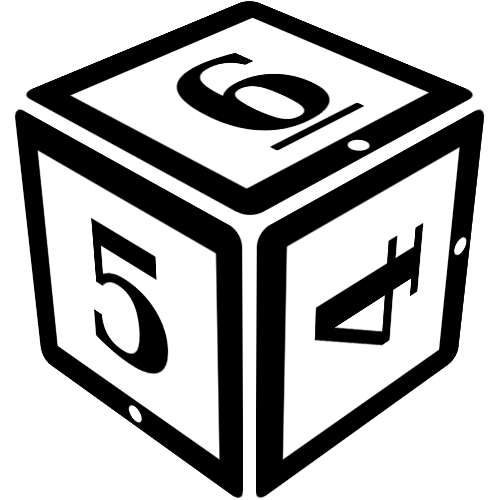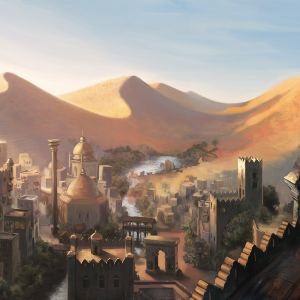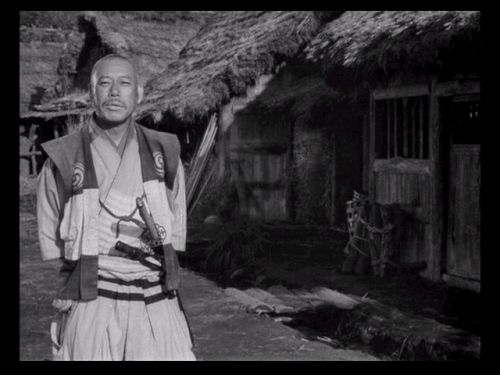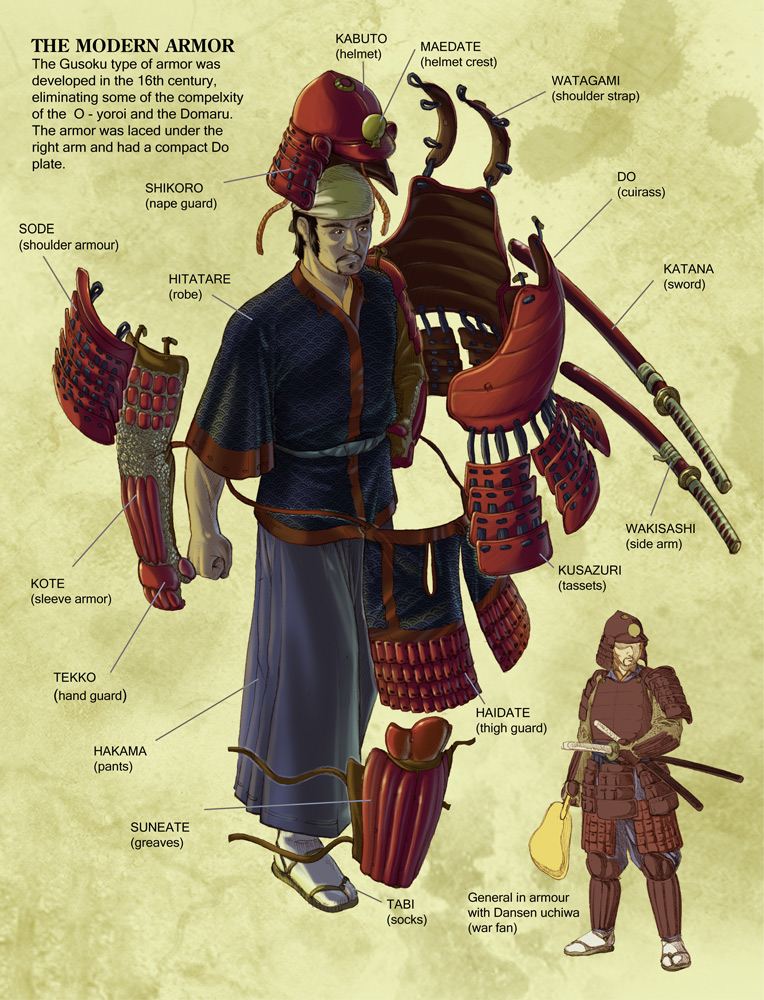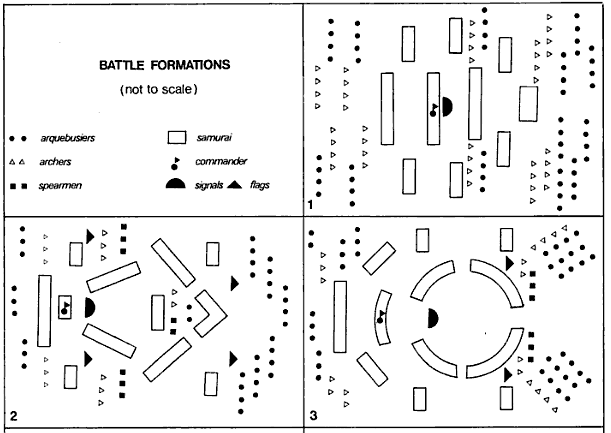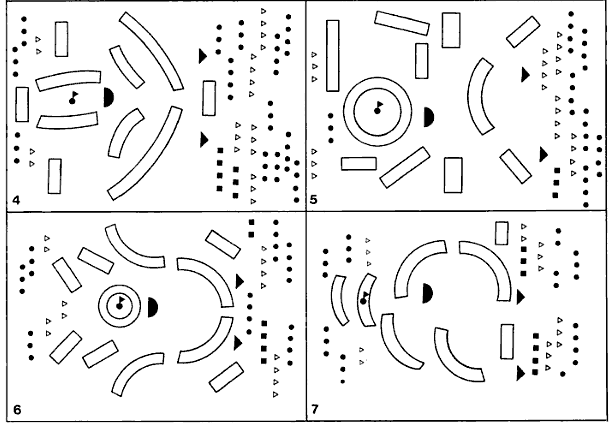Travelling samurai
Table of Contents
Physical: He is short, a little bit weighted and bald. His skin is red-brown, and he wears an elegant (green as grass, like the Haltans) moustache. He is very strong from his former soldier life. He is 42 years old.
Characteristics: A quiet, but wise man. He carries all kinds of ancient knowledges and sayings. He is very patient, but acts swiftly if he needs to.
Periphrasis: Not the destination, but the road is important.
History
The Kingdom
This Samurai Ronin comes from a tiny kingdom (it is not even on the map), wich is called Toho, in the eastern continent. Toho is located near Haltan territory, but is neutral in the war between Halta and Lilowan. He served under a king - king Akira Kurosawa - for 7 years, until he became an Exalted(tm). This day the king said: "Now you have become an Exalted(tm), you have to serve the Unconquered Sun. But be careful: you have also gained very much enemies! Never reveal your identity to strangers, and hide your caste mark!" The king gave him weapons a samurai worthy, and a beautiful horse called Shino. He also gave him command over a 1000 men's army.
Becoming Exalted(tm)
The day he became Exalted was the morning of his 35<sup>th</sup> birthday. The sun was shining unusual bright, so Kanbai searched a shelter from the hot sun. But then he heard a voice calling him, it appeared to come from the east. It said that he must not hide from the heat, but confront it, and that his life was about to change. He stepped into the light and suddenly he felt on the floor. He experienced an enormous power and didn't feel neither the sun or the floor. Then, he saw a monk. There was something familiar about him. Sequently, Kanbei awoke from his trance, feeling a burning spot on his forehead...
Becoming Ronin
After the king gave him the supplies, Kanbei didn't know what to do, and decided to remain in the capital city until he would receive instructions from his new master. But that night he couldn't sleep. He couldn't stop thinking about the monk, and while he was thinking about him, the more he remembered from the monk his life. Suddenly he knew: what he had seen was his former life! He decided to leave Toho with Shino and his army, and since then he traveled all over the world to find out more about his former life.
Kento
Kanbei's intuition told him that the answer to his questions lied somewhere in the south, and he also wanted to avoid the conflict between Lilowan and Halta. Therefore, he decided to travel to the Republic of Chaya. He travelled around the Meander River and the Maruto River, until he arrived somewhere near Mahalanka. In a small village, called Kento, he passed, people run towards him and begged him for help. They told him there were some barbarians in the neighborhood, and they didn't know how to get rid of them. Kanbei said that he would be eager to help them, but he also wanted something in return. He wanted to expand his army, so he asked the people for 100 strong men in exchange. The villagers didn't agree, but they did agree to 50 men.
And so Kanbei took his army and defeated the bandits. That was a piece of cake, because his men were already used to fight in forests, and the bandits where very outnumbered. They only had to use a simple hoshi ('arrowhead') formation. The villagers where very astonished by Kanbei's skill, and there where much young men who were eager to go with him. This resulted in 75 extra men for Kanbei.
The old ruins
After his adventure in Kento, Kanbei continued traveling to the south-east. He wanted to go to Khryal to recruit somewhat more men. A strange feeling kept telling him that he wasn't strong enough for his quest. After he traveled a long time, he engaged some old ruins. First, the old samurai wanted to stay away from them, because of the strange stories going around about them. But then, he suddenly recognized the style of the broken columns. He ordered his men to make camp, and he walked towards the ruins. He searched for some more recognizable objects, but he didn't found anything, so he went back to the camp. The next morning, Kanbei woke up early and went to the ruins again. This time he had more luck. He found a staircase going down to a hidden basement. And to his great joy, he recognized. It was the room of his vision. It was a gigantic library, but the shelves of the bookcases were empty. Disappointed that he didn't found anything he went back to his army, and marched further towards Khryal.
Khryal
In Khryal, he placed advertisements for his army, and a thousand men offered themselves as soldier. But then some dragon-blooded were curious. Kanbei was never taught about the conflict between the dragon-blooded and the solar exalted, so he offered them the job. But then his sub-commander Sichiroji told him that the dragon-blooded were asking everybody wether they knew any solar exalted. He even added that they told him that solars were evil, and that they were hunting them down. Kanbei didn't hesitate and ordered him to execute them. Then they went further, knowing that it wasn't save to stay. Kanbei traveled over the mountains, and then to the coast. Now he was more careful with advertising, but when he arrived in the igani he already had gathered 10 000 men.
Stats
{{ http://fc03.deviantart.net/fs13/f/2007/036/3/5/Samurai_Do_maru_armor_pieces_by_Onikaizer.jpg?200}}
His weapons are
- a katana (a kind of sword);
- a tanto (a ritual knife);
- a yumi (a bow);
- a yari (a lance);
- a kanabo (a mace);
- an ozutsu (a canon).
He wears a gusoku (see the image on the right →).
He also has a black horse called Shino.
He speaks two languages: High Realm and Flametongue.
Followers
In total, Kanbei has 10000 Followers
Kanbei has 5 sub-commanders; wich have each about 2000. Only Kikuchiyo does not have a command.
Sub-commanders
- Kikuchiyo (substitute commander)
Formations
Kanbei uses 7 formations:
- {{ kanbei-formations-1-2-3.png|}} Ganko (‘birds in flight’). This is a flexible arrangement of troops wich can easily be changed as the situation develops. A solid screen of arquebusiers protects the front and rear, but there are sufficient on the flanks to move round should the enemy alter his dispositions. The general is situated to the rear, but near to the centre so that communication is not lost.
- Hoshi (‘arrowhead’). This is the formation for a fierce charge, in classic Japanese style. Athinner screen of arquebuses lead the vanguard samurai, who will swoop into the gaps left by the arquebus casualties in the enemy’s ranks. A this is a highly mobile formation, the drums and other signalling devices are hedged round by the lord’s pesonal retainers. The arrowhead was desighed for rapid penetration, so the flanks are but lightly protected by bows and spears.
- Saku (‘keyhole’). This was regarded as being the best defence against the ‘arrowhead’. Six ranks of arquebuses, supported by two ranks of bows, are angled to receive the ‘arrowhead’ attack into them and to meet it with crossfire. The samurai form the shape of a keyhole around the general, to withstand the shock of the charge.
- {{ kanbei-formations-4-5-6-7.png|}} Kakuyoku (‘crane’s wing’). The best formation for surrounding your enemy. Again the arquebuses and bows soften the enemy up, followed by the vanguard samurai who engage the enemy in hand-to-hand fighting while the second company spreads out to envelop them. Note how the shape of the second company’s formation, being convexly curved, does not suggest an enemy ana immediate threat of being surrounded. Indeed, from the front an ‘arrowhead might be expected, which would be exactly what a general would want his enemy to think.
- Koyaku (‘yoke’). This formation is so called from a fanciful recsemblance to the yoke roud the necks of oxen. It was a flexible defence, ideally against a ‘crane’s wing’ but equally effectice against an ‘arrowhead’. The split vanguard could absorb a frontal attack ling enugh for the enemy’s intentions to be made evident. The second and third companies could then react accordingly, either forming a ‘keyhole’ against an ‘arrowhead’, or spreading out to avoid envelopment.
- Gyorin (fish scales’). This formation is the one to adopt if you have an army that is outnumbered by your enemy’s and you wish to break his ranks in true samurai fashion. It is basically a blunted ‘arrowhead’ for a force that has not the power to risk all in a fierce charge, but must rather maintain sustained pressure against one sector. Its name is an allusion to the shape formed by the vanguard and second company.
- Engetsu (‘half moon’). This is for a ‘backs to the wall’ situation. the army has not been surrounded, but owing to heavy losses there is great likelihood of this happening. The broken corps are pulled back, and the vanguard and other companies form a half moon that can be adapted as the situation develops. The arquebusiers arrange themselves in depth with a long rank of spearmen and archers behind.
(In the picture, imagine the enemy's armies are coming from the right.)
